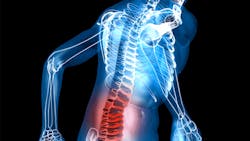NSC 2012: Nine Steps and Three Rules to Help Prevent Back Injuries
EHS professionals who attended Dennis Downing’s Oct. 24 presentation at the National Safety Council (NSC) Congress and Expo had the chance to stand up, stretch and relieve some of the tension that comes with the territory of attending a busy trade show and expo.
Downing, the founder and president of Future Industries Technologies (FIT), discussed nine strategies to help change employee behavior to help improve health and productivity. By using a balloon to represent a disc in the spine, encouraging audience participation in stretching exercises and offering some Spine 101 education (fast facts: the spine has 24 bones, three curves and is particularly vulnerable to twisting motions), Downing set about changing how we think about – and treat – our backs.
“Back injuries are ubiquitous injuries that have been around for a long time,” Downing said. “Thirty years ago, back injuries were around. They’re around today, and will be in another 30 years if we don’t address the problem.”
According to Downing, up to 80 percent of all people will experience a back injury in their lifetime. In some industries, musculoskeletal injuries account for 50-70 percent of workers’ compensation costs and lost workdays. Most back-related sprains and strains are caused by what Downing calls “micro trauma,” things like lifting children, lifting laundry, children lifting backpacks, getting in and out of vehicles, yard work and incorrect posture at computers. Innocent stresses over time can lead to discomfort, pain, joint fatigue and injury.
“If we can eliminate micro trauma on the body, we could benefit people and put them more in control of their health,” Downing said.
Follow these three rules to protect your back:
- Keep the load close to the body. This prevents micro trauma and stress.
- Keep your head neutral. When lifting something, lift with the legs and keep the head in a neutral position instead of bending the neck down.
- Keep your nose between your toes. Translation? Don’t twist when lifting. To hand something, turn and move your feet and keep your nose in the middle. Take a step and turn to face the person.
Downing also offered a nine-step plan to help promote spine and back health at work:
- Risk assessment. Identify the causes of back pain, strains, strains and injuries at work.
- Customize the program. Make your training and education program meaningful to employees.
- Use an introduction to secure employee buy-in. Create an 8-10 minute introduction to help employees understand that this program will help them avoid pain and feel healthy. After the brief introduction, encourage interaction to continue holding their interest.
- Develop you theory module. Use video, lectures, slides, photos, etc., to communicate your theory, but be sure to incorporate plenty of interaction.
- Create a customized stretching routine. Stretching can prepare the body for physical stress and relieve the body of accumulated stress. “Convince [workers] they can have control over what they feel,” said Downing, who then led the NSC attendees through some simple neck, arm and finger stretches.
- Use a kinetic learning module. At this point in the training, take employees to a space where they can do their work while applying the rules. “That’s how to delegate safety – by letting them do it,” Downing explained. “It’s got to be their own decision, and they learn by doing.”
- Question and answer. Allow employees to ask questions and feel free to question them about what they have just learned.
- Course critique. Learn what has worked and what hasn’t for employees during this training, and then modify the program base on their feedback.
- Get a commitment. Ask your workers, “Would you commit to doing at least something that you learned today for the rest of your life? Would you share something you learned today with a loved one?” Employees who make self-determined decisions will be more likely to make these positive changes.
Ideally, employees will take their new knowledge about the spine, stretching and preventing injuries and apply it in all aspects of their lives.
“You can’t just prevent injuries from 8-5,” Downing said. “It has to be a lifestyle approach.”
About the Author

Laura Walter
Laura Walter was formerly senior editor of EHS Today. She is a subject matter expert in EHS compliance and government issues and has covered a variety of topics relating to occupational safety and health. Her writing has earned awards from the American Society of Business Publication Editors (ASBPE), the Trade Association Business Publications International (TABPI) and APEX Awards for Publication Excellence. Her debut novel, Body of Stars (Dutton) was published in 2021.
